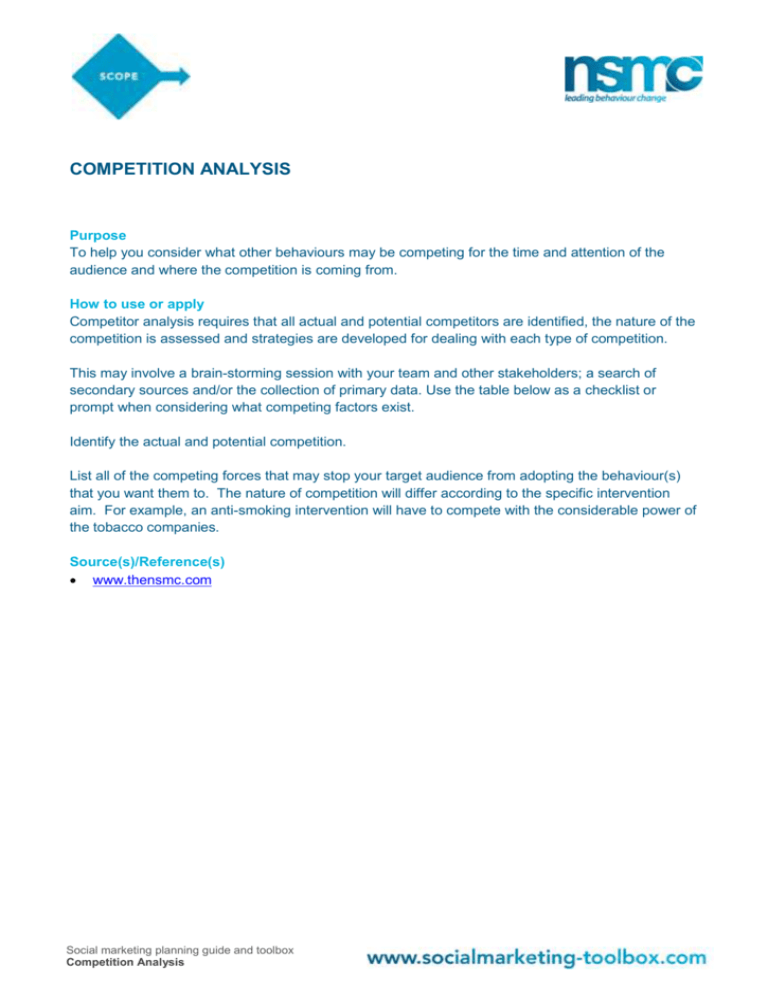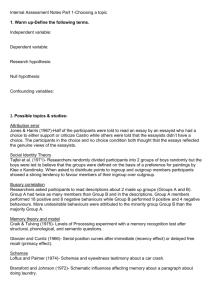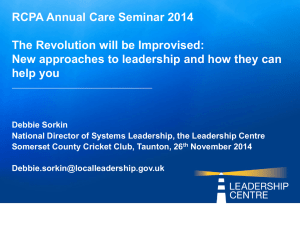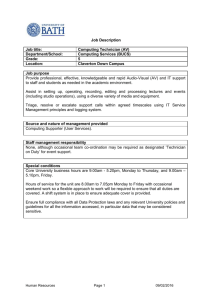Competition analysis
advertisement

COMPETITION ANALYSIS Purpose To help you consider what other behaviours may be competing for the time and attention of the audience and where the competition is coming from. How to use or apply Competitor analysis requires that all actual and potential competitors are identified, the nature of the competition is assessed and strategies are developed for dealing with each type of competition. This may involve a brain-storming session with your team and other stakeholders; a search of secondary sources and/or the collection of primary data. Use the table below as a checklist or prompt when considering what competing factors exist. Identify the actual and potential competition. List all of the competing forces that may stop your target audience from adopting the behaviour(s) that you want them to. The nature of competition will differ according to the specific intervention aim. For example, an anti-smoking intervention will have to compete with the considerable power of the tobacco companies. Source(s)/Reference(s) www.thensmc.com Social marketing planning guide and toolbox Competition Analysis DIRECT COMPETITION Competing behaviours These are the current behaviours which people are engaging in and which are the focus of the social marketing programme. They may be expressed as negative behaviours e.g. eating unhealthily or the converse of the positive behaviour, for example, not eating 5 portions of fruit or vegetables per day. Competing benefits and motivation These are the internal factors i.e. the physiological, psychological and other personal factors which people experience through engaging in the ‘negative behaviours’. Many smokers believe that smoking has therapeutic effects such as stress relief and relaxation. Over-eating can be a result of the need for a pleasurable experience and ‘comfort-eating’ is a well known phenomenon. Other benefits motivations may include the ‘buzz’ from risk-taking, pleasure and the effects of addiction. Personal influences Other factors are external to the individual. Personal influences include family, friends, work colleagues and other peer group forces which encourage the individual to engage in competing behaviours. The role of peer group is a particularly relevant one for younger age groups and has an important influence on behaviours such as smoking, drug-taking, eating, exercise patterns etc.. However, most people’s behaviours will be influenced to some extent by the people they spend time with. Further competition could be generated from the professionals and services involved, for example, the effectiveness of a programme designed to encourage safer sex for teenagers could be reduced through negative attitudes of some health workers. Wider influences Wider, impersonal influences include a wide range of organisations. A number of industries immediately spring to mind, for example, the fast food industry, the tobacco companies, drug cartels, alcohol manufacturers, retailers. These typically have considerable resources available to encourage competing behaviours through product development, branding and promotion. More recently, a number of these competitors have adopted ‘social marketing’ approaches in their product development and communications strategies, for example the healthier food options and promotion of responsible approaches to drinking. It is often worth asking whether there is a role for collaboration with competitors. The commercial sector often engages in strategic alliances with the competition, for example within the airline and car manufacturing sectors. Harnessing the power of commercial organisations can provide additional resources. Social marketing planning guide and toolbox Competition Analysis INDIRECT COMPETITION In addition to the direct competitors there are the myriad of other forces which compete for the target market’s time and attention. These include: Social marketing messages The many messages which individuals are bombarded with every day. Any one programme and communication campaign will have to compete with a variety of others. Everyday life When trying to attract the target audience’s attention and engage them in the programme you will compete, not only with all the forces above, but with ‘every day life. People have a limited amount of time and energy. Busy lifestyles and multiple commitments can underpin negative behaviours. Conversely, so can boredom and lack of financial or emotional security. Wider environmental forces Factors in the wider environment impact on the target audience and their everyday lives. These are sometimes referred to as STEEPLE factors i.e. socio-cultural, technological, economic, ecological, political, legal and ethical factors. Example initial competition analysis: Alcohol Consumption: Direct Competition Competing behaviour Excessive alcohol consumption (this should be related to the specific target market e.g. by age/gender/income/user levels). Competing benefits and motivation These may include social inclusion, relief of boredom, pleasant feelings, relaxation, escapism… Personal Influences Social group norms and peer pressure to drink excessive amounts of alcohol. Wider Influences Retailers of alcohol offer low priced products which are widely advertised. Social marketing planning guide and toolbox Competition Analysis Indirect Competition Social marketing messages The particular target audience may be receiving a whole range of messages about desired behavioural change, for example, eat less, stop smoking, take up exercise….This may distract them from our programme or build resistance to constant requests to stop behaving as they do. Everyday life Drinking is an acceptable part of everyday life for many people. In addition to social consumption alcohol is perceived as a solution to the stresses of everyday life. Changing established norms and values is a difficult process. Wider environmental forces Drinking at home is an increasing social trend. The recession is increasing the levels of stress and pressures on individuals and families through reduction in income and uncertainty about the future. Social marketing planning guide and toolbox Competition Analysis







